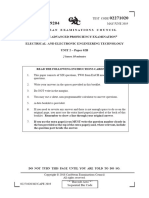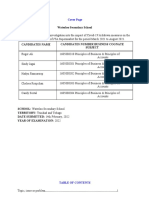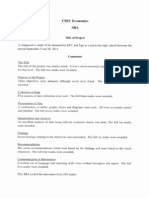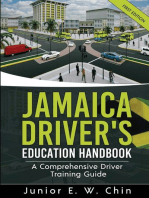CXC CSEC Exam Guide
Uploaded by
EnomikCXC CSEC Exam Guide
Uploaded by
EnomikCXC CSEC exam guide: Principles of Business (POB) Based on the CXC CSEC Principles of Business (POB) syllabus
Organization of the CXC CSEC Principles of Business (POB) exam: In-school exam candidates: The general proficiency exam consists of two (2) papers and a School Based Assessment (SBA) project. Private exam candidates: The general proficiency exam consists of three (3) exam papers.
Paper Exam time
paper 1 1hr 15 mins
Question type
Exam marks
Exam percent
Multiple choice (60 questions) Testing the three profile dimensions
60 marks
30%
Paper 2 2 hours A structured essay paper consisting of seven (7) questions divided into two (2) sections. Section A: 3 compulsory questions from section 1, 2, 5, 6 and 7 of the syllabus Section B: 4 questions, 2 questions from section 1-8 and 2 questions from section 8-10. Candidates will be required to answer 2 questions from this section. Candidates must answer all 3 questions from section A and 2 out of the 4 questions from section B. Each question will be worth 20 marks. Questions on section A contribute 60 marks and questions on section B contribute 40 marks.
100 marks
50%
SBA
A School Based Assessment (SBA) component covering the profile dimensions of the syllabus. 40 marks 20%
Paper 3
1 hr A case study for private candidates only.
40 marks
20%
Total
200 marks
100%
The syllabus for the CXC Principles of Business exam is divided into three (3) profile dimensions. Each profile dimension is comprised of several sections.
The three profiles dimensions are profile 1, 2 and 3.
Profile dimension Section 2. Internal Organizational Environment 3. Establishing A Business 4. Legal Aspects of Business top 2. Production, Marketing and 5. Production Finance 6. Marketing 7. Business Finance top 3. The Business Environment 8. The role of Government in an Economy 9. Social Accounting and Global Trade 10. Regional and Global Business Environment top
1. Organizational Principles 1. The Nature of Business
Profile 1: Organizational Principles Section 1: The Nature of Business
SPECIFIC OBJECTIVES The students should be able to: 1. Explain terms and concepts related to business
Definition and explanation of the following terms and concepts:
enterprise, entrepreneurship barter, profit, loss, trade, organization, economy, producer, consumer exchange, goods, services, market, commodity, capital, labour, specialization
2. Trace the development of instruments of exchange - Brief history
of trading instruments from subsistence economy to money economy, including the use of the following:
bills of exchange, credit cards, electronic transfer, tele-banking and e-commerce
3. State reasons why an individual may want to establish a business 4. Describe the various forms of business organizations and arrangements Forms of business organizations and arrangements: definition, formation and management of: sole trader, partnerships, co-operatives, companies (including conglomerates and multi-nationals) franchises state corporations and nationalized industries local and municipal authorities, government departments, concept of private and public sectors
5. Differentiate among the different economic systems
Types of economic systems Traditional (subsistence) Command or planned (socialist) Free of capitalist Mixed (public and private)
6. Identify the stakeholders involved in business activities
Owners, employees, customers and all other members of society
7. Discuss the role of the stakeholders involved in business
activities Role of employers, employees, consumers and government.
8. Outline the functions of a business
Functions of a business in satisfying needs and wants theough the provision of goods and services
9. Describe the role of business within a community
Economic, financial, social, political and ethical
You might also like
- Food Nutrition and Health For CSEC - PDF - Less Stress More Success Written by Experienced Teachers and Experts This Study Guide FNo ratings yetFood Nutrition and Health For CSEC - PDF - Less Stress More Success Written by Experienced Teachers and Experts This Study Guide F1 page
- Unit2 Electrical and Electronic Technology Past PapersNo ratings yetUnit2 Electrical and Electronic Technology Past Papers17 pages
- CSEC Principles of Accounts Revision Course - Basic Accounting100% (2)CSEC Principles of Accounts Revision Course - Basic Accounting9 pages
- CSEC Office Administration January 2009 P2No ratings yetCSEC Office Administration January 2009 P28 pages
- Pob Notes: Reasons For Starting A BusinessNo ratings yetPob Notes: Reasons For Starting A Business10 pages
- CSEC Information Technology January 2017 P032No ratings yetCSEC Information Technology January 2017 P03213 pages
- CXC Csec Pob January 2017 p2 1 - CompressedNo ratings yetCXC Csec Pob January 2017 p2 1 - Compressed16 pages
- CXC CSEC POB Notes - Management Information Systems100% (1)CXC CSEC POB Notes - Management Information Systems30 pages
- Csec CXC Pob Past Papers January 2006 Paper 02 PDF100% (1)Csec CXC Pob Past Papers January 2006 Paper 02 PDF6 pages
- Caribbean Examinations Council: Caribbean Secondary Education Certificate Examination 07 JANUARY 2021 (A.m.)No ratings yetCaribbean Examinations Council: Caribbean Secondary Education Certificate Examination 07 JANUARY 2021 (A.m.)32 pages
- CXC Principles of Accounts Past Paper Jan 200983% (6)CXC Principles of Accounts Past Paper Jan 20098 pages
- Jamaica Driver's Education Handbook: A Comprehensive Driver Training GuideFrom EverandJamaica Driver's Education Handbook: A Comprehensive Driver Training GuideNo ratings yet
- Preying on the Blessings of Praying: Soaring to New Heights on Wings of PrayerFrom EverandPreying on the Blessings of Praying: Soaring to New Heights on Wings of Prayer5/5 (1)
- Cape Communication Studies: Practical Exercises for Paper 02 EssaysFrom EverandCape Communication Studies: Practical Exercises for Paper 02 EssaysNo ratings yet
- Kick off Chapters 1-2-3-5 of the CCA (2) (2)No ratings yetKick off Chapters 1-2-3-5 of the CCA (2) (2)65 pages
- Reichard et al.(2024).Elevating aspiring diverse leaders through PsyCapNo ratings yetReichard et al.(2024).Elevating aspiring diverse leaders through PsyCap10 pages
- How To Make DIFFICULT Choices by Gaur Gopal DasNo ratings yetHow To Make DIFFICULT Choices by Gaur Gopal Das4 pages
- Collaboration Specialist Training v2 - Cisco Endpoints: About This LabNo ratings yetCollaboration Specialist Training v2 - Cisco Endpoints: About This Lab48 pages
- Sex Role Orientation and Leadership Style of Women ManagersNo ratings yetSex Role Orientation and Leadership Style of Women Managers7 pages
- General Machine Control - Automation Solutions For Industrial Machines - Catalogue 2014 PDFNo ratings yetGeneral Machine Control - Automation Solutions For Industrial Machines - Catalogue 2014 PDF282 pages
- Montessori Read and Write A Parent x27 S Guide TNo ratings yetMontessori Read and Write A Parent x27 S Guide T4 pages
- Schedule Line Delivery - Order Fulfillment - SAP LibraryNo ratings yetSchedule Line Delivery - Order Fulfillment - SAP Library3 pages
- 6177 - Sinhgad College of Engineering, Vadgaon (BK), PuneNo ratings yet6177 - Sinhgad College of Engineering, Vadgaon (BK), Pune16 pages
- Food Nutrition and Health For CSEC - PDF - Less Stress More Success Written by Experienced Teachers and Experts This Study Guide FFood Nutrition and Health For CSEC - PDF - Less Stress More Success Written by Experienced Teachers and Experts This Study Guide F
- Unit2 Electrical and Electronic Technology Past PapersUnit2 Electrical and Electronic Technology Past Papers
- CSEC Principles of Accounts Revision Course - Basic AccountingCSEC Principles of Accounts Revision Course - Basic Accounting
- CXC CSEC POB Notes - Management Information SystemsCXC CSEC POB Notes - Management Information Systems
- Csec CXC Pob Past Papers January 2006 Paper 02 PDFCsec CXC Pob Past Papers January 2006 Paper 02 PDF
- Caribbean Examinations Council: Caribbean Secondary Education Certificate Examination 07 JANUARY 2021 (A.m.)Caribbean Examinations Council: Caribbean Secondary Education Certificate Examination 07 JANUARY 2021 (A.m.)
- Jamaica Driver's Education Handbook: A Comprehensive Driver Training GuideFrom EverandJamaica Driver's Education Handbook: A Comprehensive Driver Training Guide
- Preying on the Blessings of Praying: Soaring to New Heights on Wings of PrayerFrom EverandPreying on the Blessings of Praying: Soaring to New Heights on Wings of Prayer
- Cape Communication Studies: Practical Exercises for Paper 02 EssaysFrom EverandCape Communication Studies: Practical Exercises for Paper 02 Essays
- Reichard et al.(2024).Elevating aspiring diverse leaders through PsyCapReichard et al.(2024).Elevating aspiring diverse leaders through PsyCap
- Collaboration Specialist Training v2 - Cisco Endpoints: About This LabCollaboration Specialist Training v2 - Cisco Endpoints: About This Lab
- Sex Role Orientation and Leadership Style of Women ManagersSex Role Orientation and Leadership Style of Women Managers
- General Machine Control - Automation Solutions For Industrial Machines - Catalogue 2014 PDFGeneral Machine Control - Automation Solutions For Industrial Machines - Catalogue 2014 PDF
- Schedule Line Delivery - Order Fulfillment - SAP LibrarySchedule Line Delivery - Order Fulfillment - SAP Library
- 6177 - Sinhgad College of Engineering, Vadgaon (BK), Pune6177 - Sinhgad College of Engineering, Vadgaon (BK), Pune

























































































